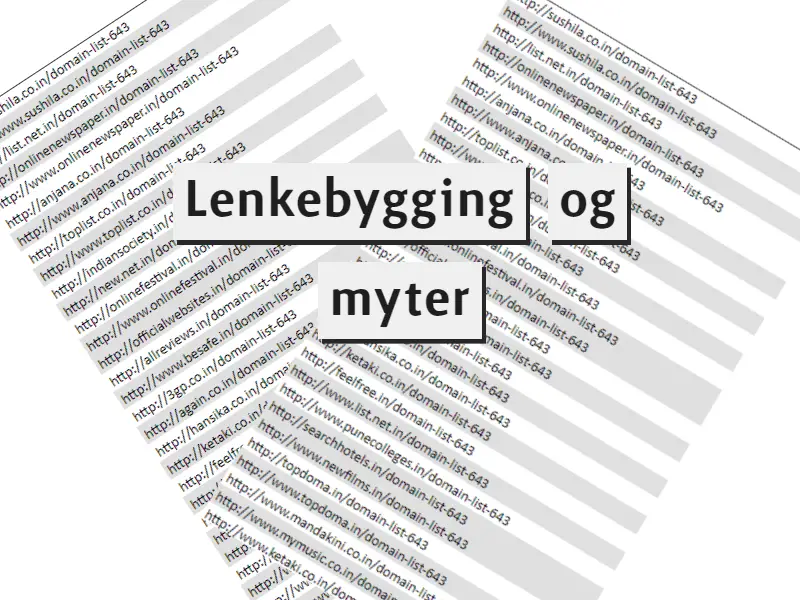PPC means pay per click. Pay per click is used as one of the most common payment methods when buying digital advertising. Another expression that is often heard instead of PPC is CPC (cost per click) and is essentially exactly the same. Beloved child has many names, and so it is in digital marketing .
What is PPC bidding?
PPC bidding is about buying in an auction-based system such as Google advertising ads and then paying a few kroner per click you get on your ad.
When using a PPC marketing method, such as Google ads, you choose keywords that you want your ads to be shown to the people searching on the internet. You pay nothing for an impression with a PPC bidding strategy, but when some potential customers click on your ads, you pay.
Therefore, you can often say that you buy a certain number of clicks for a given marketing budget. For example, Schibsted offered this when the pandemic broke out to compensate for the loss of advertising revenue in its inventory. Thus, they created PPC opportunities for small and medium-sized businesses, while traditionally they have run a pure payment per thousand impressions (CPM bidding). Cost per mille (thousand) means that you pay a certain amount per 1,000 views of your ad.
This CPM price can often vary from media house to media house. As long as there is CPM bidding, you have to pay for all impressions regardless of whether a potential customer clicks and enters your website or online store.
It therefore usually requires a larger budget than CPC/PPC bidding.
You can therefore say that starting a campaign does not involve payment, it is the results or clicks that count and for which you have to pay.
There are different types of PPC bidding, but primarily it is used when talking about paid search advertising. These campaigns appear when individuals are looking for things on the Internet using a search engine such as Google – especially when they are performing business searches or are in buying mode when searching for a product or service.
This can be anything from a mobile search such as; someone searching for “restaurant near me” on the phone to a search for services such as someone searching for a dentist or handyman nearby.
Or to someone who is in shopping mode to buy a new mobile phone searching for example “samsung galaxy 21S or needs a very high quality business service in programming or search engine optimization. All these searches fall under PPC bidding where relevant ads will be shown, but as an advertiser you don’t have to pay until someone clicks on your ad.
Why should one use PPC bidding?
By using PPC bidding to promote your business, you can create more awareness of your services and discover your exact target audience without paying before someone clicks.
Some of the advantages of using PPC bidding in the form of Google ads or similar:
- It generates interest in your products and services
- Advertisements help you catch people’s attention to your business
- Good advertisements can help increase sales and generate potential customers
- Content marketing helps to improve and increase brand awareness of your company
- Normally, you experience an increase in the audience’s engagement on the website or in your online store.
How does PPC bidding work?
In order for your ads to appear at the top of a search engine ‘s results list (commonly referred to as a Search Engine Result Page (SERP), advertisers cannot simply pay more to guarantee that their ads will appear significantly more than their competitor’s ads).
All in all, campaigns rely on what is called the Ad Auction (Google’s Ad Auction), which is a fully computerized system that Google and other search engines use to determine the relevance and legitimacy of the ads that appear in their search results (SERPs).
A number of factors determine who and what is displayed first, second and so on when the search engine shows you the list of results. There are approximately 250 different signals that determine:
- Whether an advertiser is qualified in the auction.
- The order in which qualified ads appear in the search results list (SERP).
- And not least how much each advertiser is willing to pay if their ad is clicked.
The primary factor is how much an advertiser is willing to pay for a click. Advertisers usually set a maximum amount (called Max CPC) that they are willing to pay for a click based on the keyword or search phrase. This is often expressed as an offer in the auction. The offer can be set at the specific keyword’s level or at campaign level: Campaign level in a Google ads account is a collection of related keywords. The search engines intend to show ads that searchers really want to click on. Based on this, the search engine tries to show you relevant advertising that generates revenue for Google via clicks on the campaign. Therefore, it can be said that the next factors mentioned above come into play.
An advertiser is given a quality score based on a mix of several factors that we will get into later in this article.
When an ad is eligible for the auction, the search engines perform a calculation: Max CPC x Quality Score = The ranking of the ads. This is thus used as a basis for whether an advertisement is displayed as number 1,2,3,4 and so on.
Quality points
How do keywords work in Pay Per Click (PPC) advertising?
The words that are used when searching on search engines are called keywords. One of the main criteria for advertising using PPC bidding is keywords. The keywords are linked to your company’s products and services. By using Google ads and the PPC system, you help the users of the search engines to find your website in an easy way.
To take an example:
Imagine that your company specializes in building and writing great resumes. A user who wants to write a CV can search with the keyword “create CV” in a search engine to find companies that offer help with this type of service.
When the user searches in a search engine such as Google, it uses a complex algorithm in the advertisement auction which determines which advertisements are displayed, in which order and from which advertiser.
A small tip is to remember that you have to pay for every click that occurs on your ads. Therefore, the basic foundation should be that you only want to bid in the auction on keywords that are relevant to your company.
Most players have made it easy to set up an ad by following a setup template, entering the credit card and pressing start so that the players who offer advertising space earn the most. Remember therefore that the most important thing to do when working with paid search in the form of Google ads or similar is to analyze and optimize based on the results that are created.
In what forms can PPC bidding be used?
PPC bids in Google ads can be in text format, product ads or image formats.
Text ads: Once the ad group has been created and the keywords have been selected, you start creating the ads. Campaigns should include a focus on keywords, any offers and a call to action.
Google Ads text campaign structure and character limits are as follows:
Heading 1 – Up to 30 characters (including spaces)
Heading 2 – Up to 30 characters (including spaces)
Descriptive text – Up to 80 characters (including spaces)
Ads extension 1 – Up to 15 characters
Ads extension 2 – Up to 15 characters
Advertisements cannot contain excessive capitalization, punctuation or misleading statements. Remember that the display URL will combine the root of the final URL with path 1 and path 2.
Product ads are most often referred to as Google shopping: Product ads are used in e-commerce PPC campaigns that contain product titles, images and prices all at once. It is important to note that to use Google shopping you must set up a Merchant Center at Google, and that it is best to have a live feed between the product range and the online store. The prices of the products must include VAT in order for the ads to be displayed.
Image ads
Advertisers can also use image ads in the form of various networks. The most used network for image ads is called the Google Display Network ( GDN ). This form of advertising helps you compose the message you want to promote to the user using the search engine.
The single image should describe your service. Here are some of the image sizes that can be used under image ads on Google.
- 930 x 180
- 970 x 90
- 970×250
- 980×120
- 320×50
- 320×100
- 300 x 250
- 336×280
- 580×400
- 120 x 600
- 160 x 600
- 300 x 600
- 300×1050
- 468×60
- 728 x 90
- 200 x 200
- 240×400
- 250 x 250
- 250×360
To get positive results and good impressions when using PPC bidding, good content and good keyword control is really necessary to help your business grow through good results on paid search.







